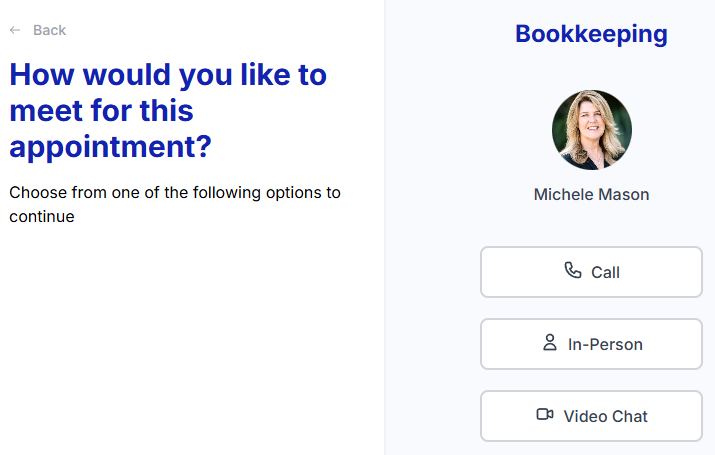
Scheduling the Old Way = Time Wasted
Here’s what scheduling looks like without an online calendar:
- Client emails: “Are you free Tuesday at 2?”
- You reply: “No, but how about Wednesday at 10?”
- Client: “Can’t do — how about next week?”
- …and on it goes.
Meanwhile, your staff is stuck juggling sticky notes, inboxes, and Outlook invites. One missed email? One double-booked time slot? Cue the frustration.
That back-and-forth isn’t just annoying — it’s a hidden labor cost. For firms managing dozens or hundreds of clients, manual scheduling can eat up hours of admin time every week.
Why Online Scheduling Works
An online scheduler flips the script:
- Self-serve booking. Clients book directly on your calendar at a time that works for both of you.
- 24/7 availability. No waiting until office hours to confirm an appointment.
- Automatic reminders. Reduce no-shows with email or text nudges.
- Integrated sync. Tied to your existing Google or Microsoft calendar to avoid double-booking.
- Flexibility. Set rules for appointment types (discovery call, tax prep meeting, planning session) with custom time blocks.
It’s convenient for clients, efficient for staff, and professional for your firm.
Scheduling shouldn’t feel like a negotiation. With online booking, it’s one click and done.
The Pros and Cons of Online Scheduling
Pros:
- Saves hours of back-and-forth communication.
- Cuts down on admin costs.
- Makes it easier for new leads to take action immediately (book a discovery call).
- Provides a modern client experience (people expect it).
- Integrates with your existing workflows.
Cons (and how to fix them):
- Fear of overexposure. Don’t want clients booking every free hour? Online schedulers let you set boundaries — only show specific days/times.
- Multiple staff needs. Good tools allow per-staff calendars and a master office calendar.
- Client confusion. Solved with clear appointment types (“Tax Prep Review — 30 min,” “Discovery Call — 15 min”).
In short: the “cons” are really just setup details. The pros heavily outweigh them.
Best Practices for Accountants Using Online Scheduling
Not all online scheduling setups are created equal. Here’s how to do it right:
- Use appointment types. Create different slots for tax prep reviews, discovery calls, and advisory sessions. This sets expectations and ensures the right amount of time is blocked.
- Set buffer times. Always add 10–15 minutes between meetings. It prevents overbooking and gives you breathing room.
- Limit availability. Don’t open your entire calendar. Choose specific days/times for client appointments so you control your week.
- Offer short discovery calls. Keep them 15 minutes. Enough to qualify a lead without eating your whole afternoon.
- Automate reminders. Use email and SMS nudges to cut down on no-shows. A simple reminder 24 hours before the appointment works wonders.
- Sync everything. Ensure your scheduler integrates with your actual work calendar (Google or Microsoft) so you don’t get double-booked.
- Make it visible. Put your booking link in your email signature, on your website, and even in nurture campaigns. The easier it is to book, the more likely they will.
Done right, your online scheduler becomes less of a tool and more of a silent assistant — keeping your calendar full and your workflow predictable.
A Client’s Experience (The Difference Scheduling Makes)
Picture this:
It’s 11:15pm. Your small business client just wrapped a 14-hour day and finally remembers: “I need to talk to my accountant about quarterly taxes.”
Old way? They draft an email, hope you see it tomorrow, and wait days for the back-and-forth to settle on a time. Stress piles up.
New way? They open your scheduling link, see your availability, and book a slot in 30 seconds flat. Confirmation + reminder land in their inbox. Done.
That client goes to bed relieved. You wake up with a fresh booking already synced to your calendar.
That’s not just convenience. That’s client experience — and it’s the kind that makes clients stay loyal.
Enter CountingWorks PRO Scheduling (Built Into ClientHub)
Why juggle yet another tool like Calendly when you could have scheduling built right into the same platform you use for everything else?
With CountingWorks PRO, scheduling is baked into ClientHub:
- Google + Microsoft sync. Real-time updates across the calendars you already use.
- Individual staff calendars. Each team member can set availability and appointment types.
- Master office calendar. One view of the entire firm’s schedule.
- ClientHub integration. Clients book directly through their secure portal — no third-party links, no confusion.
- Automation. Appointment bookings can trigger follow-up emails, reminders, or even workflow tasks (like prep checklists).
It’s scheduling, CRM, and workflow automation — all in one place.
From Chaos to Calendar Sync

The ROI of Smarter Scheduling
Let’s do the math:
- Old way: 10 minutes per appointment × 100 client meetings = 16+ hours wasted on email ping-pong.
- New way: clients self-schedule, system syncs automatically = near-zero wasted time.
Add in fewer no-shows (thanks to reminders), faster lead conversion (book now, not later), and better staff coordination, and the return on investment is massive.
The Real Payoff
Online scheduling isn’t just about convenience. It’s about:
- Freeing up staff time.
- Making it easy for new leads to engage immediately.
- Reducing friction for existing clients.
- Delivering a better client experience that feels modern, simple, and secure.
- Keeping your team organized without adding software sprawl.
The Bottom line
Stop wasting hours on email ping-pong. CountingWorks PRO’s integrated scheduler makes booking effortless for clients and painless for your staff — all while syncing to the tools you already use.














.svg)